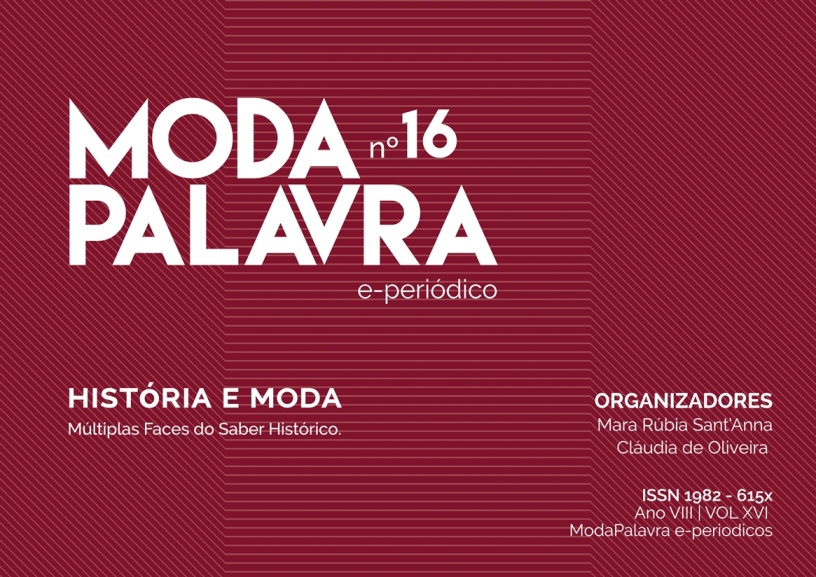The Vogue Brazil's conservative whiteness in the XXI century
DOI:
https://doi.org/10.5965/1982615x08162015037Keywords:
self-exoticism, vogue Brasil, whitenessAbstract
This reflection is part of recent interdisciplinary doctoral research about the imagery, narrative and discursive production of conservative whiteness in the high fashion journal pages and ready-to-wear luxury Vogue Brazil. Theoretical and methodological issues included notably in the fields of cultural studies, gender and postcolonial are articulated through a qualitative analysis of two fashion editorials, published in 2007 and 2008 and pointed to the "self-exoticism" of nature and Brazilian popular culture -symbolically marked by the primacy of the body [white] women, considering also the legitimacy of producing voices speeches of competence and constant renewal, and the intersection of racial symbolic violence with other forms of domination (class and gender / sexual).
Downloads
References
BENTO, Maria Aparecida Silva. Branqueamento e branquitude no Brasil. In: BENTO, M. A. S.; CARONE, Iray (Orgs.). Psicologia social do racismo: estudos sobre branquitude e branqueamento no Brasil. Petrópolis, RJ: Vozes, 2002. p. 25-57.
BOUAMAMA, Saïd; CORMONT, Jessy; FOTIA, Yvon (Dir.). Dictionnaire des dominations de sexe, de race, de classe. Collectif Manouchian. Paris: Éditions Syllepse, 2012.
BOURDIEU, Pierre. Questions de sociologie. Paris: Minuit, 1988.
______. La domination masculine. Paris: Le Seuil, 1998.
______. A distinção: crítica social do julgamento. Tradução de Daniela Kern; Guilherme J. F. Teixeira. São Paulo: Edusp; Porto Alegre: Zouk, 2007.
BURKE, Peter. Testemunha ocular. Bauru: EDUSC, 2004.
DENNISON, Stephanie. Blonde Bombshell: Xuxa and Notions of Whiteness in Brazil. Journal of Latin American Cultural Studies, 2013, Travesia, 22:3, 287-304, . Disponível em: <http://dx.doi.org/10.1080/13569325.2013.804810>. Acesso em 22/01/2014.
FALCÃO, Daniela. Ponto de vista. Vogue Brasil. São Paulo, Carta Editorial, n. 341, 2007a.
______. Classe à beira-mar. Vogue Brasil. São Paulo, Carta Editorial, n. 341, 2007b.
______. Ponto de vista. Vogue Brasil. São Paulo, Carta Editorial, n. 354, 2008.
FRY, Peter. Para inglês ver. Rio de Janeiro: Zahar, 1982.
GARCIA, Tânia da Costa. O "it verde e amarelo" de Carmen Miranda (1930-1946). São Paulo: Annablume; Fapesp, 2004.
GIACOMINI, Sonia Maria. Beleza mulata e beleza negra. Estudos Feministas. Florianópolis, ano 2, 2o semestre/1994.
HALL, Stuart. Identités et cultures 2. Politiques des différences. Paris: Éditions Amsterdam, 2013.
HOBSBAWN, Eric. Introdução: a invenção das tradições. In: HOBSBAWN, Eric; RANGER, Terence. A invenção das tradições. São Paulo: Paz e Terra, 2006.
JOLY, Martine. Introdução à análise da imagem. Campinas: Papirus, 1996.
KEBABZA, Horia. «« L’universel lave-t-il plus blanc ? » : « Race », racisme et système de privilèges », Les cahiers du CEDREF [En ligne], 14 | 2006. Disponível em: <http://cedref.revues.org.gate3.inist.fr/428>. Acesso em 13/10/2013.
LEITÃO, Débora Krischke. Brasil à moda da casa: imagens da nação na moda brasileira contemporânea. Tese de Doutorado (Programa de Pós-Graduação em Antropologia Social) –Instituto de Filosofia e Ciências Humanas –Universidade Federal do Rio Grande do Sul: Porto Alegre, 2007. 373 p.
MURARI, Luciana. O culto da diferença: imagens do Brasil entre exotismo e nacionalismo. Revista de História, 141 (1999), 45-58.
SANT’ANNA, Denise Bernuzzi de. Cuidados de si e embelezamento feminino: fragmentos para uma história do corpo no Brasil. In: SANT’ANNA, Denise B. de (Org.). Políticas do corpo. São Paulo: Estação Liberdade, 1995. p. 121-139.
SEGALEN, Victor. Essai sur l’exotisme. Paris: LGF, 1996.
VENTURA, Roberto. Estilo tropical: história cultural e polêmicas literárias no Brasil. São Paulo: Companhia das Letras, 1991.
VILLAÇA, Nízia. Mixologias: comunicação e o consumo da cultura. SP: Estação das Letras e Cores, 2010.
VOGUE BRASIL. São Paulo, Carta Editorial, n. 341, 2007.
______. São Paulo, Carta Editorial, n. 354, 2008.
Downloads
Published
How to Cite
Issue
Section
License
Copyright (c) 2015 Daniela Novelli

This work is licensed under a Creative Commons Attribution-NonCommercial 4.0 International License.
When submitting an article for publication in ModaPalavra e-periodico, the author (s) agree (s) with the following terms:
- Authors maintain the copyright in their manuscripts and grant the journal the right of first publication, with work simultaneously licensed under the Creative Commons Attribution-NonCommercial 4.0 International, which allows sharing the work with the acknowledgment of authorship and the initial publication in the journal without payment ;
- Authors may use the same results in other publications after the first publication, provided that they indicate ModaPalavra e-journal as the original publication medium;
- Authors are authorized to take additional contracts, separately, only after the original publication in ModaPalavra e-journal, provided they indicate ModaPalavra e-journal as the original publication medium;
- Authors are allowed and encouraged to publish and distribute their work online (eg in institutional repositories or on their personal page), only after the editorial process and the first publication, provided they indicate ModaPalavra e-journal as the original publication medium;
- To indicate ModaPalavra e-journal as the original publication medium, authors should use the following text template: "This article was originally published by ModaPalavra e-periodical, under a CC BY NC license, in its volume [insert volume] number [insert number] in the year of [insert year], and can be accessed at: http://www.revistas.udesc.br/index.php/modapalavra/ ";
- The opinions expressed in the articles are the author’s sole responsibility, not necessarily reflecting the journal’s opinion. The publication of any material that is owned and held in copyright by a third party, including – but not limited to - articles, photos or drawings was previously authorized by their representatives to be published in ModaPalavra e-journal.










